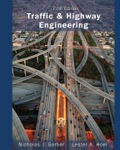
Concept explainers
The traffic characteristics with each of the levels of service for primary freeway sections.
Explanation of Solution
Introduction:
Level of service is a qualitative method which is used to describe the operating conditions of a given freeway segment. This method uses density as the variable and alphabetic grading system raging between A to F.
There is 6 basic level of service, which is described below.
- Level of service A.
- Level of service B.
- Level of service C.
- Level of service D.
- Level of service E.
- Level of service F There is a complete blockage in the traffic flow.
The vehicles move freely within the traffic stream without any interruption. Effect of incidents or point breakdown is easily absorbed.
Traffic moves under reasonably free flow condition with minimum restrictions. Effect of incidents or point breakdown is easily absorbed.
The speed of the vehicles is almost equal to free flow speed, but the free flow of the vehicles is constrained. The driver has to be cautious while shifting lanes. Small incidents are absorbed but large incidents direct to queuing of vehicles.
In the traffic stream, the free movement of vehicles is very much restricted, and there is no level of comfort. Even a minor incident leads to queuing of vehicles.
There are no good gaps between the vehicles, and the operations are unbalanced. The entry of vehicles from ramps or sub-lane leads to a blockage in the traffic flow.
Conclusion:
There are six levels of service which are represented alphabetically from A to F. Level of service A being the ideal for driving with decreasing free flow and level of service F being congested.
Want to see more full solutions like this?
Chapter 9 Solutions
Traffic and Highway Engineering
- 6000 units have been installed to date with 9,000 units to install. Labor costs are $23,300.00 to date. What is the unit cost for labor to date?arrow_forwardThe base rate for labor is $15/hr. The labor burden is 35% and 3% for small tools for the labor. There are 1000 units to install. Records indicate that trade workers can install 10 units per hour, per trade worker. The owners need 15% overhead and profit to pay bills, pay interest on loan and provide some profit to the partners. What is the minimum bid assuming no risk avoidance factor?arrow_forwardCan you show me how to obtain these answers thanks, will rate!arrow_forward
- I have the answers for part a just need help with b mostly thanksarrow_forwardPlease explain step by step and show formulasarrow_forward5. (20 Points) Consider a channel width change in the same 7-foot wide rectangular in Problem 4. The horizontal channel narrows as depicted below. The flow rate is 90 cfs, and the energy loss (headloss) through the transition is 0.05 feet. The water depth at the entrance to the transition is initially 4'. 1 b₁ TOTAL ENERGY LINE V² 129 У1 I b₂ TOP VIEW 2 PROFILE VIEW h₁ = 0.05 EGL Y₂ = ? a) b) c) 2 Determine the width, b₂ that will cause a choke at location 2. Determine the water depth at the downstream end of the channel transition (y₂) section if b₂ = 5 feet. Calculate the change in water level after the transition. Plot the specific energy diagram showing all key points. Provide printout in homework. d) What will occur if b₂ = = 1.5 ft.?arrow_forward
- 4. (20 Points) A transition section has been proposed to raise the bed level a height Dz in a 7-foot wide rectangular channel. The design flow rate in the channel is 90 cfs, and the energy loss (headloss) through the transition is 0.05 feet. The water depth at the entrance to the transition section is initially 4 feet. b₁ = b = b2 1 TOTAL ENERGY LINE V² 129 Ут TOP VIEW 2 hloss = 0.05 " EGL Y₂ = ? PROFILE VIEW a) Determine the minimum bed level rise, Dz, which will choke the flow. b) If the step height, Dz = 1 ft, determine the water depth (y2) at the downstream end of the channel transition section. Calculate the amount the water level drops or rises over the step. c) Plot the specific energy diagram showing all key points. Provide printout in Bework. d) What will occur if Dz = 3.0 ft.?. Crest Front Viewarrow_forward1. (20 Points) Determine the critical depth in the trapezoidal drainage ditch shown below. The slope of the ditch is 0.0016, the side slopes are 1V:2.5H, the bottom width is b = 14', and the design discharge is 500 cfs. At this discharge the depth is y = 4.25'. Also, determine the flow regime and calculate the Froude number. Ye= ? Z barrow_forward3. (20 Points) A broad crested weir, 10 feet high, will be constructed in a rectangular channel B feet wide. The weir crest extends a length of B = 120 feet between the banks with 2 - 4 foot wide, round nosed piers in the channel. The width of the weir crest is 8 feet. If H = 6', determine the design discharge for the weir.arrow_forward
 Traffic and Highway EngineeringCivil EngineeringISBN:9781305156241Author:Garber, Nicholas J.Publisher:Cengage Learning
Traffic and Highway EngineeringCivil EngineeringISBN:9781305156241Author:Garber, Nicholas J.Publisher:Cengage Learning
